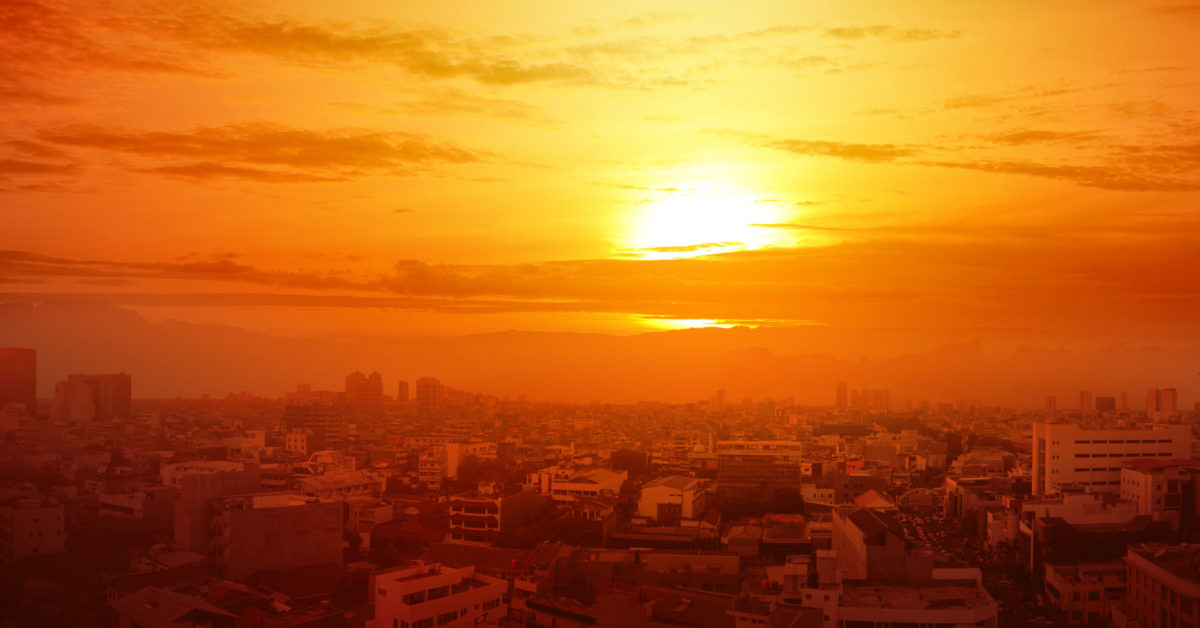Climate change is an inevitable problem that every country and government is trying to solve. Technology is being the major catalyst to identify solutions that can help municipalities fight global warming and make cities more resilient against heat waves. While Urban Heat Island (UHI) effect is impacting the livelihood, we at Gramener have worked on AI-driven solutions to fight it. Let’s talk about it more.
But first, let’s know what is Urban Heat Island effect is, how it is damaging our cities and population. Then, we’ll talk about how AI can help mitigate the impact of the UHI effect in cities.
Table of Contents

What is Urban Heat Island Effect?
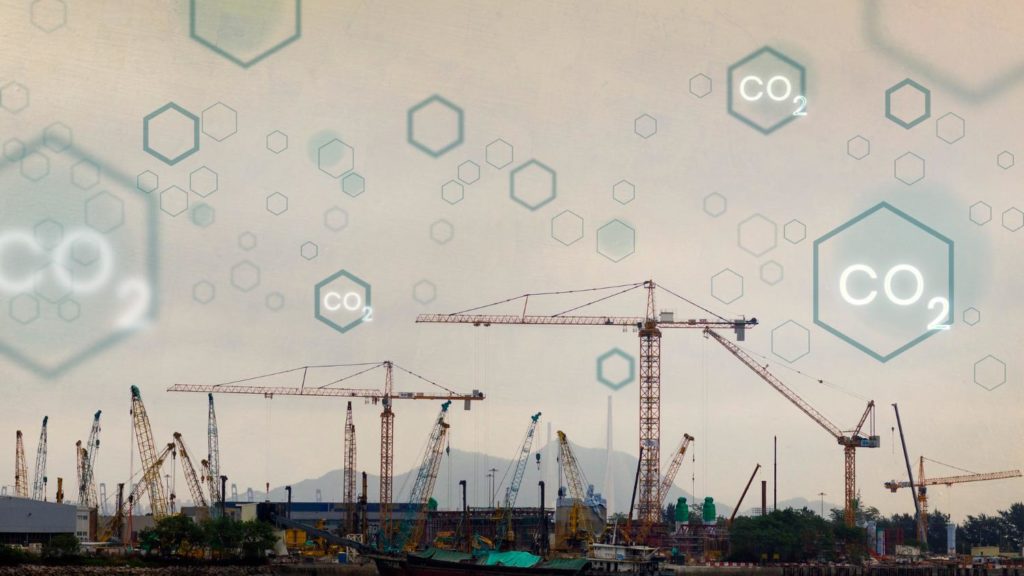
Urbanized areas that are warmer than the surrounding rural areas are called urban heat islands or UHI. This happens because the buildings, roads, and other concrete structures absorb, retain, and re-emit more heat.
These areas with greater concretization and lesser greenery as compared to the outlying areas become islands of heat. The temperature difference between these islands and their surrounding areas is 1-7 degrees during the day and 2-5 degrees at night, with the islands being warmer.
Buildings and residences are built adjacent to each other in urbanized regions. This leaves very little space for greenery. Materials such as cement, bricks, and steel are common elements in the construction of these buildings. These materials are usually dark in color and have good insulation or heat holding capacity. Moreover, the geometry of the buildings increases the trapping of heat. Thus, the areas with such buildings become warmer.
Global climate change and the UHI effect are directly proportional to each other. One may impact the other. Climate change is said to increase the intensity and frequency of heat waves.
This can increase the already high temperature of urban heat islands. Moreover, there is a marked increase in temperatures over the past couple of decades. If these trends continue, they can harm people’s health and the environment.
Causes of Urban Heat Island Effect
Here are some of the reasons causing the urban heat island effect:
Materials with Low Albedo
Albedo is the proportion of light or radiation that a surface reflects. Urban areas use construction materials that are darker and rougher and tend to have lower albedo. Thus, the overall albedo of the urban area is also low. This means that less heat would be reflected than what will be stored. In effect, this changes the local climate of the urban area by raising its temperatures.
Impermeable Surfaces
A large area of the city is concretized through pavements and buildings. These concretized surfaces are usually impermeable, and instead of absorbing the water, direct the water to rainwater management systems. In rural areas, the same rainwater gets absorbed by the surrounding surfaces, especially by the plants and water bodies. This absorption helps in cooling the rural areas through transpiration in plants and evaporation from water bodies.
Dark Surfaces
The concrete, bricks, and steel used for construction are usually black, brown, or grey. Darker colors absorb more heat than they reflect. They also tend to heat more quickly and retain that heat.
Increased Reliance on Air Conditioners
With a growing desire for comfort, we use air conditioners extensively. Air conditioners keep a structure cool on the inside, but they take heat from the interior and release it into the atmosphere. Mechanical air conditioning releases heat into the surrounding environment, aggravating the situation. As a result, the outer environment warms, causing the air temperature to rise.
Poor Natural Landscape
With greater concretization comes lesser vegetation cover. Plants and trees help keep their surroundings cool through transpiration. The water pulled up by their roots is distributed through their stems to the leaves, from where it evaporates from the underside of the leaves. This helps cool the surrounding air. In cities though, this opportunity is lost to a great degree.
The Geometry of Buildings
The heat entrapment in cities is higher because of the building geometry. The shapes of different buildings and their positions alter the wind flow and the ability of the construction materials to absorb and release heat energy.
- Urban Canopy: Narrow lanes and tall buildings form an urban canopy. This canopy traps more heat and restricts natural wind flow that could have naturally cooled the buildings and surrounding areas.
- Thermal Mass: Cities typically use materials, such as bricks, tiles, and concrete that have high thermal mass. This means these materials need a lot of heat energy to raise their temperature, and therefore, they absorb more heat than the surroundings. These materials also store the absorbed heat for a longer period.
Greater Human Activity
Cities are centers of enhanced human activity. Human activities require vehicles, air conditioners, buildings, and infrastructural units. The extra heat released from these anthropogenic sources increases the UHI effect.
Impact of Weather and Geography
Weather conditions such as calm and clear skies tend to enhance urban heat stress. This is because such weather allows more heat to reach the surface of the city buildings while lesser heat is radiated. Similarly, geographical features such as mountains can also impact the heat conditions of nearby areas. Mountains can alter wind flow, thereby restricting or enhancing the wind that passes through a city.
Global Climate Change
Climate change has led to increased heat waves. The extreme heatwaves also increase the heat island effect. The heat island feeds the climate change, thereby forming a vicious circle.
Effect of Urban Heat Island on People & Economy
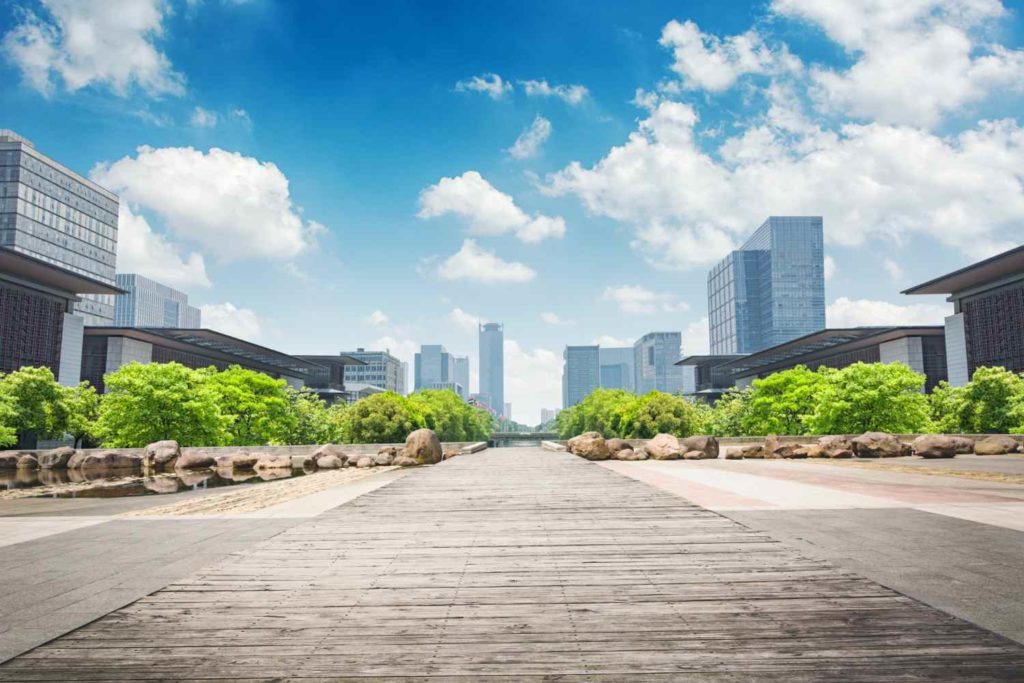
The U.S. EPA outlines the impact of the heat island on people’s health and the economy. Heat islands can have extremely high temperatures which can lead to heat-strokes and fast exhaustion. The effects of heat can be dire at times leading to death. Isn’t this a reason enough to build more solutions to fight the urban heat island effect?
The following groups of people face issues due to the heat island effect:
- Older people: Older adults often have poor health, low mobility and they tend to live alone. This increases the danger of heat strokes to their lives.
- Children: Children are in a developing stage of their lives, with their respiratory systems still developing. Increased temperatures due to the heat island effect can increase air pollution and smog, which can cause respiratory troubles for children. They are also vulnerable to quicker exhaustion because of their small size.
- Outdoor workers: People who spend more time working outdoors are more prone to heat-related issues. These people are susceptible to urban heat stress and pollution due to higher exposure rates.
- People with low incomes: These people cannot afford good housing. Their houses often lack air conditioning, and the living space is congested. This increases their vulnerability to heat-related illnesses.
- People with poor health conditions: Chronic diseases, disabilities, and medications can increase people’s susceptibility to heat stress.
Effect of Urban Heat Island on Utilities
The UHI effect can also increase the electricity load and consumption. This is because of the increase in energy requirements for air conditioning. The heat island effect compounds the global warming effect, thereby increasing the cooling requirements in urban areas.
Some problems this could lead to are:
- Increased power outages: The increased load on electricity puts the electricity infrastructure under pressure. This results in increased load shedding and power outages.
- Investment in new electricity infrastructure: Electricity transformers sometimes catch fire due to short-circuiting and excessive load. This may necessitate system overhauls and investment in new systems. As per a U.S. CCSP report, the need for additional generating capacity would increase by 10-20% by 2050. This could mean an additional expense of billions of dollars.
- Increased pollution: Increased air conditioning requirements will also imply increased emissions and a consequent increase in air pollution. This will, in turn, contribute to climate change.
The overall economic cost of the urban heat island effect is estimated to be in billions of dollars. As per an economic assessment done just for the city of Melbourne in Australia, it was estimated at $300 million. We can imagine the global impact. It has also been found that the impacts on personal well-being cannot be quantified.
The urban heat island is likely to impact several activities and sectors such as:
- Health: Increased cost of ambulance and other infrastructure maintenance for increased cases of heat-related illnesses.
- Transport infrastructure: Increased cost of maintenance for rail and road transport with overheating of trains and trams, buckling of railway tracks, and break down of cars and buses.
- Anti-social behavior: As per some researchers fromt he USA, crime has a positive linear relationship with hot weather. Thus, with an increase in temperature to 90ºF (32.2ºC) or higher, the rate of crimes such as collective crimes, assault, homicide, rape, robbery, domestic violence, and non-aggressive crimes increases. These crimes have a high cost to society in terms of vandalized property, increased policing, courts and correctional facilities, and damage inflicted on innocent people.
- Flora and fauna: Increased temperatures also harm flora and fauna. While native species of trees and plants can sustain hot temperatures with less irrigation, the exotic variants have lesser tolerance. Moreover, if species are adapted to survive at high temperatures, their transpiration rates and consequent cooling benefits tend to be less. Animals can suffer due to the heat island effect both directly as health impact and indirectly as lack of flora-based food resources. Lack of flora and fauna can reduce the amenity value of the urban spaces.
Tips to Reduce the UHI Effect and Build Resilient Cities
With the clear negative impact of urban heat islands on cities, there is a need for climate-resilient cities. Some of the solutions listed below can be helpful for reducing the urban heat island effect:
White-Roofing and Light-Colored Concrete
Making roofs white-colored and using light-colored materials for roads and buildings can help reflect up to 50% of the incident sunlight. As a result, the ambient temperature will reduce, which will also reduce the demand for cooling.
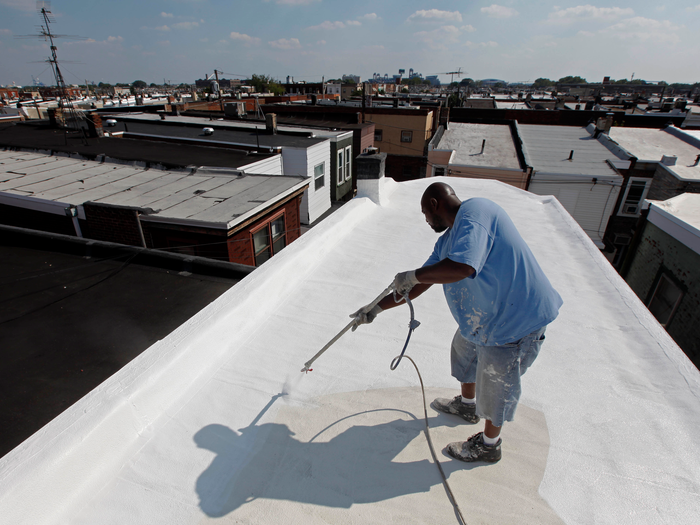
Green-Roofing
Terrace gardens and plants on the roof are a sustainable solution for reducing ambient temperatures. Plants and grass on the roofs can work as heat absorbers. However, the heat is put to use for the transpiration process. Plants and grass release water vapors and oxygen making the ambient air fresh. This is also one of the ways to combat the climate change effect on cities.
Vegetation Cover
Planting trees within and near the cities is a cost-effective way of reducing urban heat stress and increasing urban resilience. While they need some time to grow, trees can provide shade and oxygen, and absorb pollution and carbon dioxide. Consequently, they have a cooling effect on the environment.
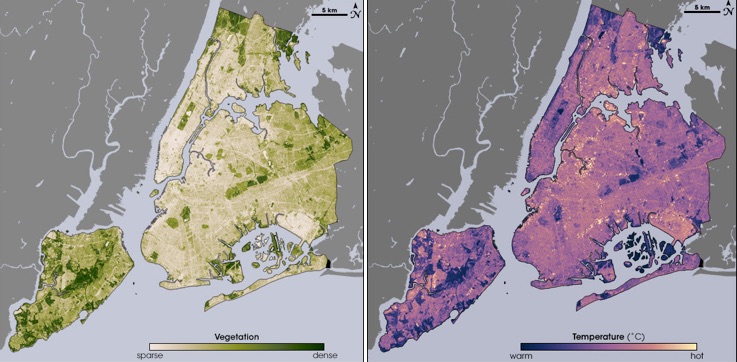
The above NASA/USGS satellite Landsat images show the cooling effects of plants in New York City. The dark green spots in the left image are the densely planted areas that correspond to the dark purple spots on the right showing lower temperatures.
Parking Lots with Greenery
One of the latest trends for urban island heat mitigation is the creation of green parking lots. Green cover created strategically in parking lots can prevent stormwater runoff and also the overheating of pavements.
Stringent heat reduction policies and frameworks: It is necessary to put some policies in place, such as the standards for low carbon fuel and the use of renewable energy for urban island heat mitigation. Awareness drives can inform the community about best practices.
Water Features
When it’s hot outside, everyone wants to be near water, and water features may help a city cool down. Moving water produces spray and has more cooling capacity than still water, which is why some classic architectural types include a fountain in the center of a shaded courtyard.
AI Solution to Reduce Urban Heat Island Effect
While climate change and the urban island heat effect pose a daunting future, new-age technology such as AI and techniques like spatial analysis and GEOAI offers practical solutions.
One such solution to beat the UHI effect is from Gramener in partnership with Evergreen and Microsoft AI for Earth. This solution offers scalability to the data generated. This solution can gather the temperature of every single rooftop across municipalities in Canada and store it in one place.
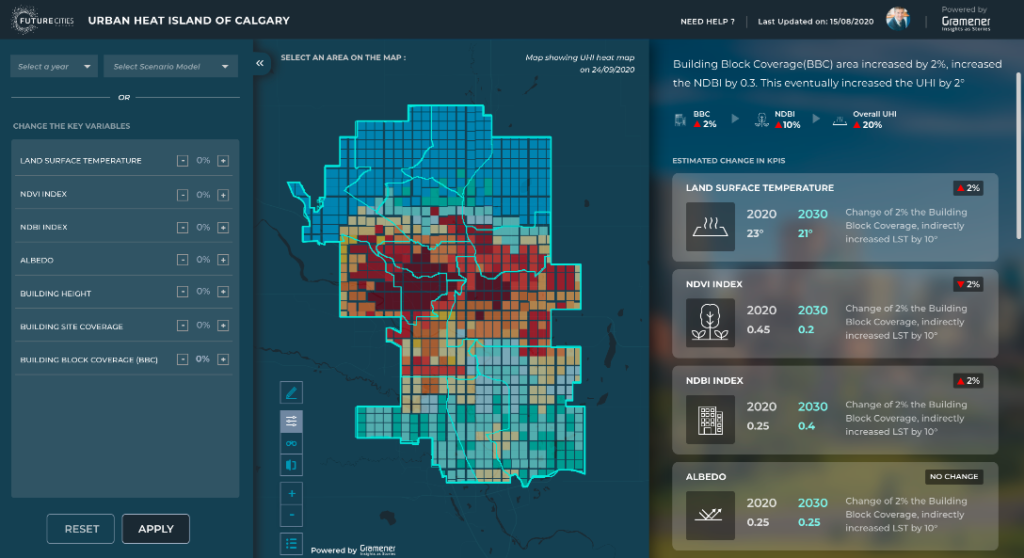
The tool is built on the Microsoft Azure cloud computing service and will help in tackling various climatic hazards such as flooding and earthquakes. The 3-D data visualization will help in getting answers to the following:
- As per the climatic conditions, what was the city’s structure 5 years ago?
- As per previous climatic trends, what will the city look like in 50 years?
- By altering environmental conditions, what kind of changes are likely in the city’s resilience?
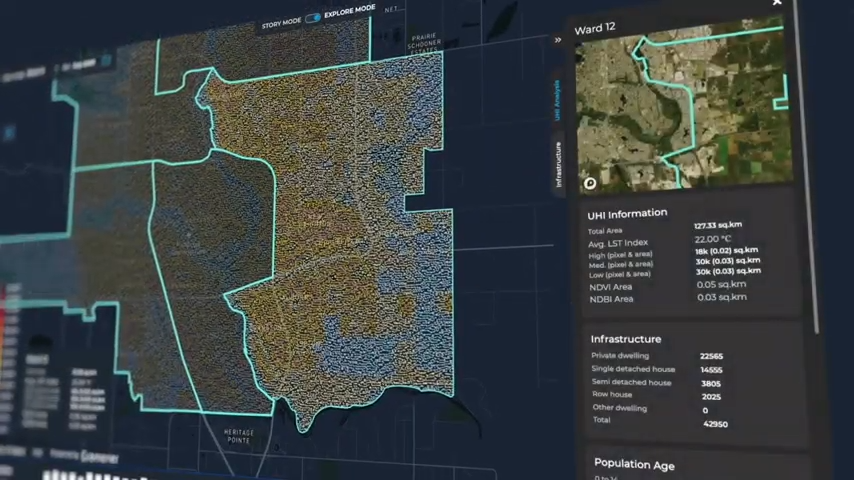
This tool can help the cities to evaluate future infrastructure projects. It can help in better planning for mitigating the heat island effect and climate change risk. With this tool, one can plan not just for the urban heat index but also for infrastructure concepts related to flooding, forest fires, land use, and permafrost.
Benefits of Reducing the UHI Effect in Cities
- Lower smog exposure
- Lower air pollution
- Reduced energy cost, increased energy cost savings
- Reduction in health ailments caused by heat exposure
- Reduction in mortality caused by excessive heat exposure
- Better water quality and aquatic habitat because of reduced pollutants
- More outdoor recreation because of enhanced vegetation cover and cooling
- Reduced electricity demand
- Reduced fuel consumption for electricity generation
- “Green collar” job creation for labor for green cover installation and maintenance
The benefits of reducing the urban heat island effect show how important it is for cities and countries to deploy technology solutions like Gramener’s and beat this effect.
Contact us for custom built low code spatial analytics solutions for your business challenges and check out ESG and AI solutions built for our clients, including Fortune 500 companies. Book a free demo right now.

